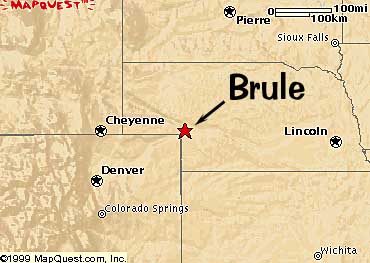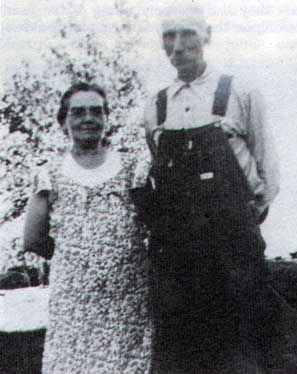Trip to Brule Nebraska
April 10, 1996
By Bob Zimmerman
|
|
|
The narrative captured in this story comes directly from the comments of those we met. In all, over eight hours of recordings were made.
The historical data, which gives life to the region and people, was gathered from several sources, including:
Boyle, Donzella Cross, Quest
of a Hemisphere, Western Islands, 1970
INTRODUCTION Brule is located along the South Platte River in Keith County, Nebraska, a scant 15 miles east of Colorado. This area is but a portion of the Great Plains region, a region often referred to as the "Great American Desert." The plains extend from northwestern Canada through parts of Manitoba, Saskatchewan, and Alberta and into the United States, where they continue south to Texas. The landscape was largely formed as beds of sands, gravels, silts, and muds were deposited by streams flowing from the Rocky Mountains to the west. Over the top of these deposits is a layer of wind deposited silt, often called loess. Being in the center of the North American continent, the area has what is known as a "continental climate" with hot summers and bitterly cold winters. Record highs have been recorded up to 118 degrees in the summer of 1936, to record low temperatures of minus 47 degrees in 1899. Annual rainfall averages only about 15 inches. Fertile soil coupled with scant precipitation is the ideal combination for grassland. Before the farmers began turning the sod, the area was a vast sea of tough, course blue-stem bunch grass and short green buffalo grass which sustained enormous herds of bison. These animals came to North America from Eurasia by crossing the Bering Strait land bridge in prehistoric times. Until the 19th century, as many as 60 million bison lived on the Great Plains from Mexico into Canada, and some were found east of the Mississippi River. The bison were central to the existence of the Plains peoples who used them for food, hides, and bone implements. Even the dried dung, called buffalo chips, was used as fuel. Brule got its name from the local inhabitants of the area, which in itself is an interesting story. In January, 1886, Major Isaac Barton and his wife Elizabeth purchased a quarter section of land in the area. In short order a post office was established in a general store and "the postmaster, Jacob Griffin, quite naturally supposed the town would be named after the founders so he constructed and painted a sign with the name Barton. Upon checking with the Bartons he found this was quite contrary to their desire. The name of this new town should be Brule after the Sioux Indians of the same name. In 1872, 5000 of the Brule Sioux, under their leader, Chief Spotted Tail, camped on the area the town now covers. It was the Barton's belief that the heritage of these great warriors was far more significant to the area than the family name Barton would ever imply. Needless to say, the postmaster repainted the sign and Brule became officially named at that time."
Pictured to the right is Katherine and George Kammer. The picture most likely was taken in the 1930's. When and why my grandfather moved from Iowa to Nebraska are questions that are presently not known. Did George, perhaps, want to take advantage of government policies of the time? The Homestead Act of 1862 "provided that any adult citizen (or person intending to become a citizen) who headed a family could qualify for a grant of 160 acres of public land by paying a small registration fee and living on the land continuously for five years. If the settler was willing to pay $1.25 an acre, he could obtain the land after only six months' residence." Did George move to Boone County, Nebraska to get his 160 acres of land? It is also not known why my grandfather moved from Boone County, Nebraska to Keith County, but the history of the times leaves room for speculation. The Kansas-Nebraska Act of 1854 authorized the creation of the states of Kansas and Nebraska. By opening up what had been Native American country to white settlement, northern Senators "hoped to facilitate construction of a transcontinental railroad through their states rather than through the southern part of the country." In 1867, the Union Pacific became the first railroad to cross the state. The rails of the Union Pacific, reaching westward from Omaha, Nebraska, and those of the Central Pacific Railroad, reaching eastward from Sacramento, California, were joined at Promontory, Utah, in 1869, completing the coast-to-coast connection. This railway construction, however, was expensive. It was estimated that construction of the transcontinental railroad would cost approximately $50,000 per mile. To subsidize the construction cost, the United States government agreed to give federal aid to the railroad companies and deed them title to the land adjoining the tracks as the work progressed. This was known as the Pacific Railroad Act, signed into law by President Lincoln in July, 1862. "Under provisions of the Pacific Railroad Act, the Union Pacific was to receive the odd numbered sections of land up to twenty sections in width on each side of the mainline." The tracks near Brule were laid sometime around June, 1867. The railroads could not prosper without passengers and freight. Since they now had title to land adjoining the tracks, they began advertising their lands for sale. Quest of a Hemisphere explains it well: Farmers were encouraged to buy land along the railroads to be near markets and thus save the freight costs of long hauls. The railroads published guide books, free, to sell their lands. They offered time payments, one-fifth as a down payment and the remainder in five years. On the cover page of one of these folders was the following quotation from a poem by Whittier: I hear the tread of pioneersThese guide books warned immigrants to beware of swindlers and gave advice on many matters-the kind of clothes needed, what seed to bring, the nature of the soil, climate, and scenery. Stout-hearted men and women sometimes faltered at the task of beginning life anew in a sod shanty on the lonely prairie. In the railroad folders were words of encouragement, like the following: It is better to be poor for a few years on your own land than to be moderately poor as a tenant for others.This clever advertising was aimed at the home-seeking immigrants with a longing for land. I wonder if my grandfather happened across some of this Union Pacific advertising and was convinced that better land was to be had in western Nebraska? Or perhaps he had friends who were also moving to the area. Apparently he had managed to do fairly well, either in Boone County or prior, since when he, Katherine and their two small daughters Bessie and Fern moved from Boone County to Brule in 1909 they were able to put $2500 down on a $6000 quarter section of land. These were interesting times. Theodore Roosevelt was President of the United States with his "Square Deal" and his "walk softly but carry a big stick" foreign policy. And who knows, perhaps George and Katherine stood in the middle of their field in May of 1910 and saw Haley's comet as it made its spectacular approach to the sun! |
||
| FWD to Day 1 | � | |
|
|
| Please send me email or leave a comment in my guest book. |
| Learn MORE ABOUT ME | Return to TOP of THIS Page | Return to BOBS HOMEPAGE |
| Revised 02-25-00 |
 I first
heard of mom's idea of returning to Brule, Nebraska
at a business meeting of The HerbFarm in Fall City,
Washington, in the spring of 1996. The HerbFarm is
a business that mom started almost twenty years ago
and it has grown into a major enterprise. Her idea
was to return to the town where she was born, visit
the old farm and meet with other relatives and
friends. And best of all, she wanted me and my wife
Valorie to go along, all expenses paid! Her only
request was that I try to capture this trip in a
story, to be shared and enjoyed by others.
I first
heard of mom's idea of returning to Brule, Nebraska
at a business meeting of The HerbFarm in Fall City,
Washington, in the spring of 1996. The HerbFarm is
a business that mom started almost twenty years ago
and it has grown into a major enterprise. Her idea
was to return to the town where she was born, visit
the old farm and meet with other relatives and
friends. And best of all, she wanted me and my wife
Valorie to go along, all expenses paid! Her only
request was that I try to capture this trip in a
story, to be shared and enjoyed by others.
 Many of the settlers in this
area were the grandchildren and the great
grandchildren of the first pioneers who had moved
into the Northwest Territory and Kentucky after the
close of the Revolutionary War. My great
grandfather, George Kammer, was born in
Pennsylvania in 1847 and migrated westward into
Iowa. His son, my grandfather, also named George,
was born on May 9, 1874 in Zwingel, Iowa. He
married Katherine Bartlett on April 20, 1898.
Many of the settlers in this
area were the grandchildren and the great
grandchildren of the first pioneers who had moved
into the Northwest Territory and Kentucky after the
close of the Revolutionary War. My great
grandfather, George Kammer, was born in
Pennsylvania in 1847 and migrated westward into
Iowa. His son, my grandfather, also named George,
was born on May 9, 1874 in Zwingel, Iowa. He
married Katherine Bartlett on April 20, 1898.